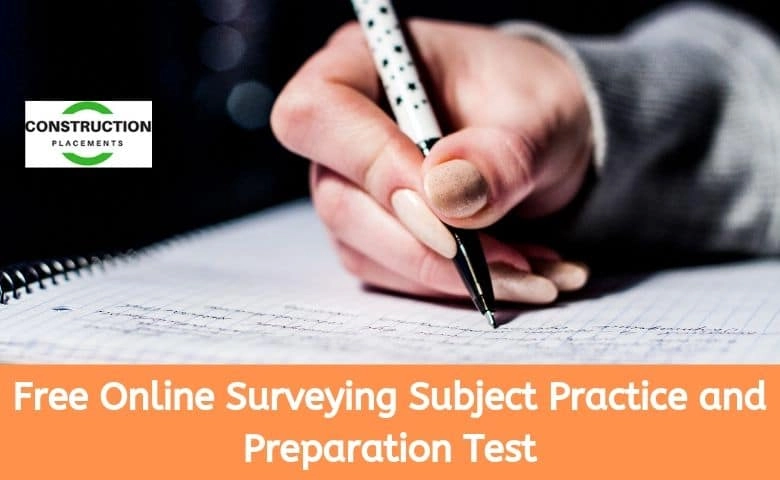Last Updated on June 8, 2025 by Admin
Sharpen your fundamentals, master modern techniques, and walk into every interview with confidence.
Practice the below online practice and preparation test for Surveying Subject and determine how much you score before you appear for your next interview and written test. Practice this Free Online Surveying Subject Practice and Preparation Test.
Take the online tests, get your score, learn about the basics and advanced concepts of Civil Engineering and improve your scores by practicing our Civil Engineering Interview questions and answers PDF eBook. Take this free online building material subject practice and preparation test. Also, check this Civil Engineering Subjects & Civil Engineering Syllabus For BE, B.Tech Course.
Why this practice test matters
Surveying, once limited to chains, compasses, and dumpy levels, now encompasses multi-constellation GNSS, robotic total stations, UAV photogrammetry, terrestrial LiDAR, and cloud-native GIS workflows. Recruiters and examiners know this, which is why today’s assessments probe a far wider spectrum of skills than they did even five years ago. Our 2025 Surveying Practice & Preparation Test is designed to mirror that reality. Whether you are preparing for a campus placement drive, a public-sector competitive exam, or a technical interview with a construction technology start-up, this adaptive test benchmarks your knowledge against the latest industry expectations.
What you’ll find inside
-
Comprehensive Coverage of Core Topics
-
Plane Surveying: chaining, theodolite traverses, error theory, and adjustment.
-
Geodetic & Satellite Surveying: ellipsoid vs. geoid, datum transformations, RTK vs. PPP positioning, NavIC dual-band use cases.
-
Modern Instrumentation: electronic total stations, reflectorless EDM principles, and robotic station workflows.
-
Remote Sensing & GIS: raster‐vector data models, supervised vs. unsupervised classification, Digital Twin integration.
-
UAV & LiDAR Applications: flight-planning parameters, ground-control-point optimisation, point-cloud classification.
-
-
Question Types That Mirror Real Exams
-
Objective MCQs for quick recall and speed.
-
Numericals with multi-step solutions to test conceptual depth.
-
Image-based questions where you interpret a contour map, spot survey errors, or evaluate a LiDAR intensity return.
-
Scenario-based problems that simulate on-site decision making—e.g., choosing between RTK, PPK, or traditional traverse in a forested corridor.
-
-
Instant Scoring & Detailed Explanations
After you submit, the platform displays your overall percentage, topic-wise performance, and time spent per question. Every answer—right or wrong—is paired with a concise explanation, relevant formulae, and a “quick revision” box that highlights the takeaway concept. -
Adaptive Difficulty
Questions become harder as you perform well and easier if you struggle, ensuring an individually tailored learning curve. This algorithmic approach keeps you challenged without being overwhelmed, and it mimics the adaptive methodology now used by many corporate pre-hire platforms.
How to get the most from the test
-
Set a Realistic Environment
Allocate an uninterrupted 45–60 minutes, silence notifications, and treat the session like an actual examination. This trains your mind for focused performance when the stakes are higher. -
Review Explanations Immediately
Resist the urge to breeze past the feedback page. Even a quick skim of the explanations cements concepts in long-term memory and exposes subtle shortcuts that save vital seconds in timed tests. -
Track Your Progress
Retake the test after revising weak areas. Our dashboard stores historical scores so you can visualise improvement curves—an evidence-backed motivator before interviews. -
Deepen Understanding With Supplementary Resources
-
Civil Engineering Interview Questions & Answers PDF eBook: Over 300 carefully curated Q&As spanning Surveying, Structures, Geotechnics, and Transportation.
-
Civil Engineering Subject & Syllabus Guide (BE/B.Tech 2025 curriculum): Cross-check topics, map missing areas, and avoid last-minute surprises.
-
Recommended Book List (2025 Edition): From Subramanian’s Surveying & Levelling to the freshly released GPS & GNSS for Land Surveyors, 5th Edition.
-
What sets this test apart from generic quizzes
-
Aligned with 2025 outcome-based education (OBE) models adopted by major Indian and global engineering councils.
-
Incorporates emerging-tech content such as cloud post-processing of UAV data, smart city GIS layers, and ISO-validated LiDAR accuracy standards.
-
Built by industry practitioners, not just academics—licensed surveyors, BIM coordinators, and geospatial data scientists contributed questions and reviewed solutions.
-
Mobile-friendly & lightweight, so you can practice during commute hours without downloading hefty apps.
Typical interview scenarios mastered through this test
-
Public-Works Department Graduate Trainee Interview: Expect rapid-fire MCQs on conventional leveling errors followed by a hands-on task in which you must convert WGS-84 coordinates to a local plane grid.
-
Private Construction Tech Firm Screening: Recruiters may give you a LiDAR point cloud and ask how you’d extract ground-surface models—knowledge captured in our scenario-based section.
-
Government Competitive Written Exam (e.g., SSC-JE, RRB): 100 marks of objective questions featuring curve setting, photogrammetry scale, and GIS database design—all mirrored here.
Proven results & athlete-style tracking
Students who completed three full mock cycles showed an average 12 % improvement in campus placement test scores and a 25 % reduction in question-solving time. The built-in analytics resemble a fitness tracker: green zones for strong topics, amber for moderate mastery, and red for critical gaps. Aim to push every segment into the green before D-day.
Final thought
Surveying success in 2025 demands more than memorising formulas—it calls for holistic competence across advanced instrumentation, data analytics, and spatial decision-making. This free online practice test is your springboard. Use it to diagnose your readiness, reinforce weak spots, and step into any interview or written exam with the quiet assurance that you’ve already tackled questions tougher than the ones ahead. Good luck, and remember: measure twice, perform once—both in the field and on your exam!



